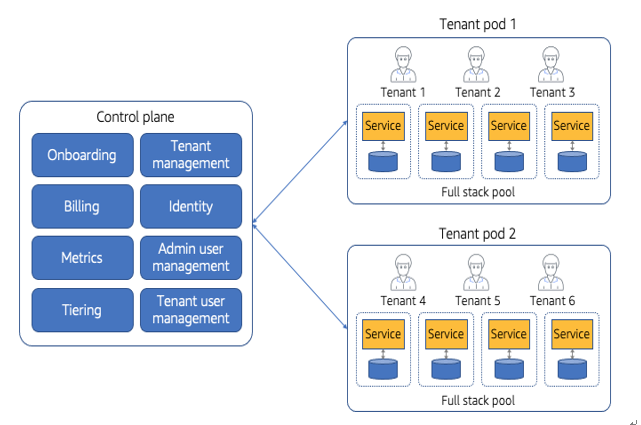The Pod Deployment Model
So far, I’ve mostly looked at deployment models through the lens of how you can represent the application of siloed and pooled concepts. We explored coarse- and fine-grained ways to apply the silo and pool model across your SaaS environment. To be complete, I also need to step out of the silo/pool focus and think about how an application might need to support a variation of deployment that might be shaped more by where it needs to land, how it deals with environmental constraints, and how it might need to morph to support the scale and reach of your SaaS business. This is where the pod deployment model comes into the picture.
When I talk about pods here, I’m talking about how you might group a collection of tenants into some unit of deployment. The idea here is that I may have some technical, operational, compliance, scale, or business motivation that pushes me toward a model where I put tenants into individual pods and these pods become a unit of deployment, management, and operation for my SaaS business. Figure 3-12 provides a conceptual view of a pod deployment.

Figure 3-12. A pod deployment model
In this pod deployment model, you’ll notice that we have the same centralized control plane on the left-hand side of this experience. Now, however, on the right-hand side, I have included individual pods that are used to represent self-contained environments that support the workload of one or more tenants. In this example, I have Tenants 1-3 in pod 1 and Tenants 4-6 in pod 2.
These separate pods bring a degree of complexity to a SaaS environment, requiring your control to build in the mechanisms to support this distribution model. How tenants are onboarded, for example, must consider which pod a given tenant will land in. Your management and operations must also become pod aware, providing insights into the health and activity of each pod.
There are a number of factors that could drive the adoption of a pod-based delivery model. Imagine, for example, having a full stack pooled model running in the cloud that, at a certain number of tenants, begins to exceed infrastructure limits of specific services. In this scenario, your only option might be to create separate cloud accounts that host different groups of tenants to work around these constraints. This could also be driven by a need for deploying a SaaS product into multiple geographies where the requirements of that geography or performance considerations could tip you toward a pod-based deployment model where different geographies might be running different pods.
Some teams may also use pods as an isolation strategy where there’s an effort to reduce cross-tenant impacts. This can be motivated by a need for greater protections from noisy neighbor conditions. Or, it might play a role in the security and availability story of a SaaS provider.
If you choose to adopt a pod model, you’ll want to consider how this will influence the agility of your business. Adopting a pod model means committing to absorbing the extra complexity and automation that allows you to support and manage pods without having any one-off mechanisms for individual pods. To scale successfully, the configuration and deployment of these pods must all be automated through your control plane. If some change is required to pods, that change is applied universally to all pods. This is the mirror of the mindset I outlined with full stack silo environments. The pod cannot be viewed as an opportunity to enable targeted customization for individual tenants.
One dynamic that comes with pods is this idea of placing tenants into pods and potentially viewing membership within a pod as something can be shifted during the life of a tenant. Some organizations may have distinct pod configurations that might be optimized around the profile of a tenant. So, if a tenant’s profile somehow changes and their sizing or consumption patterns aren’t aligned with those of a given pod, you could consider moving that tenant to another pod. However, this would come with some heavy lifting to get the entire footprint of the tenant transferred to another pod. Certainly this would not be a daily exercise, but is something that some SaaS teams support–especially those that have pods that are tuned to a specific experience.
While pods have a clear place in the deployment model discussion, it’s important not to see pods as a shortcut for dealing with multi-tenant challenges. Yes, the pod model can simplify some aspects of scale, deployment, and isolation. At the same time, pods also add complexity and inefficiencies that can undermine the broader value proposition of SaaS. You may not, for example, be able to maximize the alignment between tenant consumption and infrastructure resources in this model. Instead, you may end up with more instances of idle or overprovisioned resources distributed across the collection of pods that your system supports. Imagine an environment where you had 20 pods. This could have a significant impact on the overall infrastructure cost profile and margins of your SaaS business.
